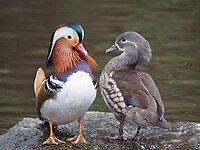
Photo from wikipedia
Wild plant species provide excellent examples of qualitative traits that evolve in response to environmental challenges (e.g., flower color, heavy metal tolerance, cyanogenesis, and male sterility). In addition to such… Click to show full abstract
Wild plant species provide excellent examples of qualitative traits that evolve in response to environmental challenges (e.g., flower color, heavy metal tolerance, cyanogenesis, and male sterility). In addition to such discrete characters, a dazzling array of continuously distributed, quantitative traits are expressed at every phase of the life cycle. These traits are known or suspected to have evolved by natural selection because they are heritable, differ among populations or closely related taxa occupying distinct habitats, and have individual phenotypes associated with survival and reproductive success. This special issue [American Journal of Botany 109(11)] focuses on the tools and approaches for detecting or inferring the ecological and genetic factors contributing to changes in genetically based variation of quantitative traits within or among populations, or causing their divergence among taxa. The assembled articles use one or more of three primary approaches to detect the process or outcome of natural selection on morphological, life history, reproductive, chemical, and physiological quantitative traits: the analysis of phenotypic or artificially imposed selection to detect direct and indirect selection on traits whose function is well-understood; common garden experiments, including reciprocal transplants and "resurrection" experiments; and quantitative genetic analyses designed to detect and to estimate the environmental and genetic sources of phenotypic variation or to forecast short-term evolutionary change. Together, these articles examine and reveal the adaptive capacity of quantitative traits and the genetically based constraints that may limit their directional evolutionary change, thereby informing and testing inferences, hypotheses, and predictions concerning the evolutionary trajectories of wild plant species.
Journal Title: American journal of botany
Year Published: 2022
Link to full text (if available)
Share on Social Media: Sign Up to like & get
recommendations!